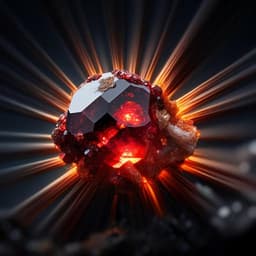
Chemistry
High-performance light-driven heterogeneous CO<sub>2</sub> catalysis with near-unity selectivity on metal phosphides
Y. Xu, P. N. Duchesne, et al.
Discover the groundbreaking potential of metal phosphides as photothermal catalysts for efficient solar-driven CO2 hydrogenation. This research, conducted by dynamic authors from the University of Toronto and Sun Yat-sen University, reveals impressive CO production rates and stellar selectivity. Join the journey toward innovative solutions in CO2 catalysis!
~3 min • Beginner • English
Introduction
Heterogeneous catalysis occurs on solid surfaces and can be driven thermochemically, electrochemically, biochemically, or photochemically. Catalyst performance depends on electronic, geometric, and support effects, and on the number and nature of surface-active sites, which are often heterogeneous and can evolve under reaction conditions, impacting selectivity and stability. Ideally, catalysts would present uniform, stable active sites with controlled size and facets, but this is rarely achieved. Metal phosphides offer atomic and crystalline precision, comprising highly dispersed metal nanoclusters integrated in a phosphorus lattice. While they have shown promise in electrochemical hydrogen evolution and hydroprocessing, their potential in heterogeneous (photo)catalytic CO2 hydrogenation is underexplored. This study investigates Ni12P5 as an archetypal metal phosphide for light-driven CO2 hydrogenation via the reverse water-gas shift (RWGS), aiming to achieve high activity, near-unity CO selectivity, and long-term stability, and examines extension to Co2P analogs.
Literature Review
Prior work has established that catalyst structure, particle size, and facet exposure strongly influence CO2 hydrogenation selectivity over nickel-based catalysts, with higher H2 ratios, higher temperatures, and increased CO2 conversion often promoting methane formation, while smaller Ni particles favor CO formation. Transition metal phosphides have been widely investigated for hydrogen evolution and hydroprocessing, and theoretical studies suggest unique surface chemistries (e.g., Ni2P surfaces) beneficial for C1 reactions and water-gas-shift. Photothermal CO2 hydrogenation catalysts, including black indium oxide and alloy systems, have demonstrated the advantage of broadband light absorption driving thermal reactions. Commercial Fe–Cr catalysts are benchmarks for RWGS but show lower photothermal rates under similar conditions. These insights motivate exploring metal phosphides, which combine strong, broadband light absorption with isolated metal ensembles that may direct CO2 hydrogenation toward RWGS with high CO selectivity.
Methodology
Materials synthesis: Ni12P5 nanoparticles were synthesized via temperature-programmed reduction (TPR) of nickel phosphate oxides formed from nickel nitrate and (NH4)2HPO4 (Ni:P = 12:5). Precursors were dried at 120 °C, calcined at 550 °C for 6 h, then reduced under 10% H2/Ar at 600 °C for 6 h with ramps of 10 °C min−1 (25→300 °C) and 2 °C min−1 (300→600 °C). SiO2-supported Ni12P5 (x wt% Ni12P5/SiO2; x from ICP-OES) was prepared by incipient wetness impregnation using the same precursors and reduction protocol. A Ni/SiO2 control was prepared similarly without phosphate, reduced at 350 °C. Co2P and Co2P/SiO2 were synthesized analogously (Co:P = 2:1), reduced at 720 °C.
Characterization: XRD (Bruker D2 Phaser) confirmed tetragonal Ni12P5 phase (PDF#74-1381). UV–vis–NIR diffuse reflectance (Perkin Elmer Lambda 1050) assessed broadband absorption. TEM/HRTEM (FEI T12 G2; Hitachi H-7650) determined particle sizes (unsupported Ni12P5: 86 ± 30 nm; supported: 13 ± 7 nm at 10.4 wt%, 9 ± 3 nm at 5.2 wt%, 8 ± 4 nm at 3.1 wt%). Lattice spacings matched Ni12P5 planes. XPS (Phi 5500) showed near-zero-valent Ni (852.6, 869.6 eV) and P (129.5, 130.3 eV) with slight charge transfer (Ni δ+, P δ−). H2 chemisorption assessed Ni dispersion (assumed Ni/H = 1). XAS (APS 9-BM Quick-EXAFS) under in situ CO2/H2 (5:1) at 300–350 °C: Ni K-edge XANES indicated metallic character; EXAFS R-space showed Ni–P (~0.163 nm) and Ni–Ni (~0.264 nm) shells; fitting gave Ni–Ni bond length 2.510 Å (vs 2.480 Å Ni foil) and reduced coordination number ~7 ± 1.
Photocatalytic testing: Batch reactor (11.8 mL stainless steel with fused silica window). Catalyst (0.5 mg) drop-cast on 1 cm2 borosilicate microfiber filter, dried at 80 °C. Reactant gases (CO2 15 psi, H2 3 psi; total 18 psi ~1.2 bar). Unfiltered 300 W Xe lamp, calibrated 2.3 W cm−2 over 1 cm2; no external heating. Reaction time 0.5 h; products analyzed by GC (SRI-8610, Mole Sieve 13x and Haysep D columns; FID/TCD). Recyclability: sequential runs with evacuation/refill. Light-intensity dependence via neutral-density filters (ND 0.1, 0.3, 0.5) and spectral dependence via high-pass cut-offs (≥420, ≥495, ≥590 nm). 13CO2 labeling using GC–MS (Agilent 7890A, GS-CarbonPLOT column).
Flow reactor long-term tests: Quartz capillary reactor (ID 2 mm), continuous flow CO2 2.5 sccm, H2 0.5 sccm, temperature controlled (OMEGA CN616A). Illumination 0.8 W cm−2; apparent temperature e.g., 290 °C. Products analyzed by GC as above. Tests under dark thermal conditions and under illumination at matched apparent temperatures to assess photothermal enhancement.
In situ DRIFTS: Nicolet iS50 with MCT detector, Harrick Praying Mantis accessory and high-temperature chamber (ZnSe windows). Samples pretreated at 350 °C under He (20 sccm) for 2 h; spectra collected (128 scans, 4 cm−1) under CO2/H2/He flows (5/1/14 sccm) at 300 °C and varied temperatures.
Data analysis: Internal quantum yield estimated; local catalyst surface temperature under illumination estimated using ASPEN Plus from equilibrium CO2 conversion. Time-resolved in situ XANES monitored stability under simulated RWGS conditions.
Key Findings
- Ni12P5 exhibits broadband UV–vis–NIR absorption; supported samples show reduced absolute absorbance due to dilution but maintain catalytic phase and crystallinity.
- EXAFS/XANES reveal largely metallic Ni character with strong Ni–P bonding, stretched Ni–Ni bonds (2.510 Å vs 2.480 Å) and reduced Ni coordination (≈7), indicating well-dispersed, low-coordinate Ni nanoclusters embedded in P lattice.
- Photothermal RWGS performance in batch (2.3 W cm−2, CO2/H2=5:1, ~1.2 bar, no external heating):
• Unsupported Ni12P5: CO rate 156 ± 3 mmol gcat−1 h−1, CO selectivity 99.5 ± 0.1%.
• 10.4 wt% Ni12P5/SiO2: peak CO rate 960 ± 12 mmol gcat−1 h−1, CO selectivity 99.7 ± 0.1% (≈5.2× enhancement vs unsupported). Lower loadings: 5.2 wt% 678 ± 13; 3.1 wt% 334 ± 10 mmol gcat−1 h−1, selectivity ~99.7%.
• Isotope labeling confirms CO originates from CO2 (13CO m/z 29 observed).
• Rate vs light intensity fits exponential behavior; visible and NIR light drive reaction, consistent with photothermal mechanism rather than direct photochemical charge transfer.
• Estimated local surface temperature under 2.3 W cm−2 reaching ~401 °C (wet) or ~381 °C (dry) at 7.48% CO2 conversion (batch, 11.5 h), demonstrating strong photothermal heating.
- Stability:
• Batch recyclability: rate and selectivity retained over eight runs; post-reaction XRD and XPS show no metallic Ni formation and unchanged Ni/P binding energies.
• In situ XANES under CO2/H2 (1:5 v/v) at 300–350 °C: no significant spectral changes over 60 min, indicating structural stability.
• Flow reactor 100 h (0.8 W cm−2, 290 °C, CO2 2.5 sccm, H2 0.5 sccm): initial CO rate 13.5 mmol gcat−1 h−1, selectivity 99.9%; after 100 h, 13.3 mmol gcat−1 h−1 and 99.8%. Control Ni/SiO2 lost 76% activity and selectivity dropped to ~85%.
• Under purely thermal conditions (dark) at 320 °C: 8.03 mmol gcat−1 h−1; with illumination at same apparent temperature: 25.6 mmol gcat−1 h−1 (2.2× enhancement), more pronounced at lower temperatures.
• TEM after 100 h: Ni12P5/SiO2 particle size increased slightly (13→14 nm) with high crystallinity retained; metallic Ni nanoparticles showed significant sintering, attributed to suppressed Ni(CO)4 formation on phosphides mitigating Mond process.
- Mechanism and selectivity:
• In situ DRIFTS at 300 °C shows dominant linearly bonded Ni–CO (2082 cm−1) and weaker bridge-bonded Ni–CO (~1920 cm−1); peak positions independent of loading, with FWHM broadening at lower loadings indicating distribution of linear CO sites. Absence of formate signatures suggests direct CO2 dissociation RWGS pathway.
• P-induced ensemble effect isolates Ni sites (increased Ni–Ni spacing, reduced coordination), disfavors multi-coordinate CO binding, weakens CO binding energy, and facilitates CO desorption, suppressing methanation; near-100% CO selectivity maintained across CO2/H2 ratios (1:5 to 5:1) and temperatures (160–320 °C), and largely independent of particle size.
- Extension to Co2P: Orthorhombic Co2P (and Co2P/SiO2) also shows broadband absorption and high RWGS performance with CO rates of 15.7 mmol gcat−1 h−1 (unsupported) and 227.7 mmol gcat−1 h−1 (supported), with >99% CO selectivity and stability over six cycles, supporting generality of metal phosphide platform.
Discussion
The study demonstrates that embedding Ni in a phosphorus lattice (Ni12P5) produces isolated, low-coordinate Ni nanoclusters that enforce a reaction pathway dominated by linearly bonded CO intermediates, enabling efficient CO desorption and suppressing further hydrogenation to methane. This site isolation and modified electronic/geometric environment (ensemble effect) explains the near-unity CO selectivity that remains robust against variations in particle size, reactant ratio, and temperature—contrary to conventional Ni catalysts where selectivity is highly condition- and size-dependent. The catalyst’s strong, broadband optical absorption efficiently converts light to heat, delivering high local temperatures under illumination and driving the RWGS reaction via a photothermal mechanism; this provides a solar advantage, particularly at lower apparent temperatures. Structural probes (XANES/EXAFS, TEM) and long-term tests confirm that Ni12P5 maintains its structure and resists sintering, likely due to suppression of Ni(CO)4-mediated Mond processes on phosphide surfaces. Extending the concept to Co2P, which also comprises P-separated metal nanoclusters, yields similarly high selectivity and significant activity, indicating that transition metal phosphides are a general platform for selective photothermal CO2-to-CO conversion. These findings address the initial goal of achieving site-precise heterogeneous catalysis with controllable activity, selectivity, and stability under light-driven conditions.
Conclusion
Ni12P5 functions as a high-performance photothermal catalyst for CO2 hydrogenation via the RWGS reaction, achieving a peak CO production rate of 960 ± 12 mmol gcat−1 h−1 with near-100% selectivity and excellent long-term stability. The key lies in phosphorus-driven ensemble effects that isolate Ni sites, favor linear CO binding and facile CO desorption, and in strong broadband light absorption that enables high local temperatures under illumination. The approach generalizes to Co2P, suggesting transition metal phosphides are a promising, cost-effective class for solar-driven CO2-to-CO catalysis. Future research could explore broader metal phosphide chemistries, optimize supports and morphologies to maximize light harvesting and heat management, integrate with downstream CO conversion (tandem catalysis), and scale-up reactor designs for practical solar thermochemical applications.
Limitations
- Performance depends on photothermal heating; absolute rates scale with light intensity and catalyst optical absorption, leading to lower rates and IQY at lower loadings due to reduced light harvesting.
- Activity and mechanism were evaluated primarily for RWGS; formation of hydrocarbons or alcohols was not observed under tested conditions, indicating the system is specialized for CO production rather than multi-carbon synthesis.
- Local catalyst temperatures under illumination were inferred via equilibrium conversion and ASPEN Plus estimation rather than directly measured at the nanoscale.
- Long-term stability was validated up to 100 h under specific flow and illumination conditions; broader operating windows and scale-up effects remain to be assessed.
- Study focuses on Ni12P5 and Co2P; generality to other metal phosphides and different supports requires further validation.
Related Publications
Explore these studies to deepen your understanding of the subject.







